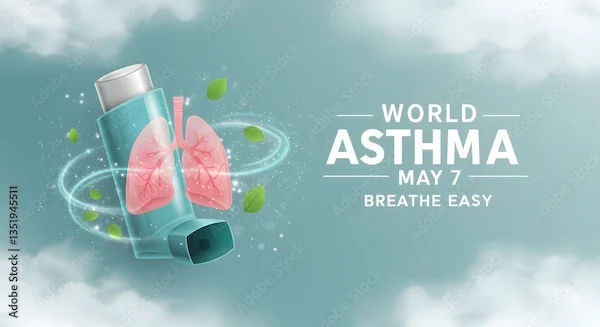Understanding Intrinsic Asthma Symptoms and Causes
Explore intrinsic asthma: understand its unique symptoms, common triggers (not allergies!), and how it differs from allergic asthma. Learn about diagnosis & management.

Written by Dr. Mohammed Kamran
Reviewed by Dr. D Bhanu Prakash MBBS, AFIH, Advanced certificate in critical care medicine, Fellowship in critical care medicine
Last updated on 21st Nov, 2025

Asthma is a common respiratory condition that affects millions of people worldwide. While most people are familiar with allergic (extrinsic) asthma, triggered by allergens like pollen or dust, intrinsic asthma is less commonly discussed. If you or a loved one experiences asthma symptoms without any obvious allergic triggers, you might be dealing with intrinsic asthma.
This article will help you understand what intrinsic asthma is, its symptoms, causes, and how to manage it effectively.
What Is Intrinsic Asthma?
Intrinsic asthma, also known as non-allergic asthma, is a type of asthma that is not triggered by allergens like pollen, pet dander, or dust mites. Instead, it is caused by internal factors such as stress, infections, cold air, exercise, or irritants like smoke and strong odors.
Unlike allergic asthma, which is more common in children, intrinsic asthma often develops in adults over the age of 30. It can be more challenging to manage because the triggers are not always obvious.
Common Symptoms of Intrinsic Asthma
The symptoms of intrinsic asthma are similar to those of allergic asthma but occur without exposure to typical allergens. These include:
Wheezing (a whistling sound while breathing)
Shortness of breath
Chest tightness
Persistent coughing (often worse at night)
Difficulty breathing during physical activity
These symptoms can range from mild to severe and may worsen during respiratory infections or exposure to irritants like smoke or pollution.
What Causes Intrinsic Asthma?
Unlike allergic asthma, which is linked to an overactive immune response to allergens, intrinsic asthma is triggered by nonallergic factors, such as:
1. Respiratory Infections – Colds, flu, or sinus infections can inflame the airways, leading to asthma symptoms.
2. ExerciseInduced Triggers – Physical exertion, especially in cold or dry air, can cause airway constriction.
3. Stress & Strong Emotions – Anxiety, laughter, or crying can sometimes trigger asthma attacks.
4. Weather Changes – Cold air, humidity, or sudden temperature shifts can worsen symptoms.
5. Irritants in the Air – Smoke (tobacco, fire), strong perfumes, cleaning chemicals, or air pollution can irritate the airways.
6. Hormonal Changes – Some women experience worsened asthma symptoms during menstruation or menopause.
How Does Intrinsic Asthma Affect Health?
If left untreated, intrinsic asthma can lead to:
Frequent asthma attacks, requiring emergency care
Reduced lung function over time
Chronic fatigue due to poor sleep from nighttime coughing
Increased risk of respiratory infections
The good news is that with proper management, most people with intrinsic asthma can lead active, healthy lives.
Tips for Managing Intrinsic Asthma
While intrinsic asthma cannot be cured, its symptoms can be controlled with the right approach. Here are some practical tips:
1. Identify and Avoid Triggers
Keep a symptom diary to track what worsens your asthma (e.g., cold air, stress, smoke).
Avoid smoking and secondhand smoke.
Use a scarf or mask in cold weather to warm the air before breathing.
2. Follow Your Asthma Action Plan
Work with your doctor to create a personalized asthma management plan.
Use controller medications (inhaled corticosteroids) daily if prescribed.
Keep rescue inhalers (like albuterol) handy for sudden symptoms.
3. Strengthen Your Lungs
Practice breathing exercises (like diaphragmatic breathing) to improve lung function.
Engage in moderate exercise (swimming, walking) to keep lungs healthy.
4. Manage Stress & Infections
Practice relaxation techniques (yoga, meditation) to reduce stress-induced asthma.
Get yearly flu shots and stay updated on vaccinations to prevent infections.
5. Maintain a Clean Indoor Environment
Use an air purifier to reduce indoor pollutants.
Avoid strong perfumes or chemical cleaners that may irritate your airways.
When to See a Doctor?
If you experience:
Frequent wheezing or shortness of breath
Worsening symptoms despite using an inhaler
Asthma attacks requiring emergency care
It’s important to consult a pulmonologist or asthma specialist for proper diagnosis and treatment.
Consult Top Specialists
Need Help? Book a Consultation Today!
If you suspect you have intrinsic asthma or need expert guidance, Apollo 24|7 offers easy online consultations with respiratory specialists. You can also schedule lung function tests to assess your condition.
Take control of your breathing—schedule an appointment today!
Final Thoughts
Intrinsic asthma can be unpredictable, but understanding its triggers and symptoms is the first step toward better management. With the right lifestyle adjustments and medical support, you can minimize flare-ups and breathe easier.
If you have concerns about your asthma symptoms, don’t hesitate to seek professional advice. Your lungs deserve the best care!
Would you like to learn more about asthma treatments or lifestyle tips? Let us know in the comments!
Consult Top Specialists
Consult Top Specialists

Dr. Ashwani Kumar
Ent Specialist
11 Years • MBBS, DNB (Otorhinolaryngology)
Delhi
Apollo Hospitals Indraprastha, Delhi
(50+ Patients)

Dr. Safina Kauser
Ent Specialist
7 Years • MBBS, MS
Bengaluru
Apollo Clinic, JP nagar, Bengaluru

Dr. Aijaz Muzamil
Ent Specialist
46 Years • MBBS, Ms ENT
Bengaluru
Apollo Clinic, Sarjapur Road, Bengaluru

Dr. Chava Anjaneyulu
Ent Specialist
24 Years • MS,ENT, (AIIMS, New Delhi), consultant ENT surgeon
Hyderabad
Apollo Hospitals Jubilee Hills, Hyderabad

Dr. Puja Chatterjee
Ent Specialist
7 Years • MBBS, MS (AIIMS, Delhi), DNB, MRCS-ENT (Royal College of Surgeons, England)
Bengaluru
Apollo Clinic, JP nagar, Bengaluru




